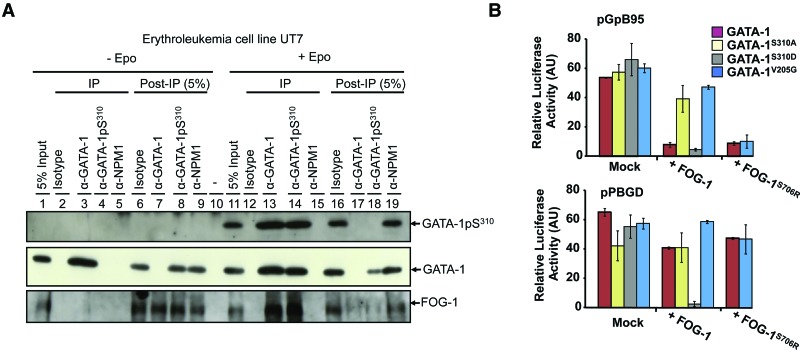Figure 1.
Phosphorylation of GATA-1 at Ser310 by AKT enhances the association of GATA-1 with FOG-1 and regulates transcription. (A) Immunoprecipitation and Western blotting to examine GATA-1/FOG-1 association in Epo-starved and Epo-stimulated UT7 cells. Immunoprecipitations were carried out on equal amounts of nuclear extract (500 µg per point). Specific antibodies (α-) that recognize GATA-1 phosphorylated at Ser310 (GATA-1pS310), GATA-1, or nucleophosmin (NPM1) proteins were used in immunoprecipitation experiments (IP), and 5% of supernatants after immunoprecipitation (post-IP 5%), as indicated, were subjected to Western blotting with α-GATA-1, α-GATA-1pS310, and α-NPM1 antibodies. As a control, we also ran 5% of nuclear extracts before immunoprecipitation (5% input) (see also the legend for Supplemental Figure S1). (B) Luciferase assays to analyze the effect of FOG-1 on the GATA-1-mediated transactivation of GATA-specific erythroid promoters (see also Supplemental Fig. S2): NIH-3T3 cells were transiently transfected with a luciferase reporter gene driven by the minimal erythroid-specific promoter of the glycophorin-B promoter (pGpB95) or the erythroid porphobilinogene deaminase promoter (pPBGD; nucleotides −714 to +78), and cells were cotransfected with Migr-derived plasmids encoding GATA-1 or one of the GATA-1 mutants with and without FOG-1 or the FOG-1S706R variant that binds GATA-1V205G or GATA-1, as indicated. Error bars indicate the standard deviation from three independent experiments performed in triplicate.

